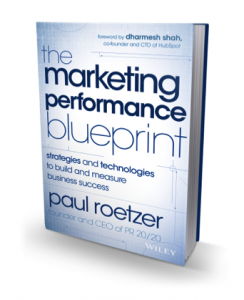Q&A with Paul Roetzer, Author of The Marketing Performance Blueprint

The marketing talent gap is very real. As we found in our State of Digital Marketing Talent study, “only 8% of those surveyed believe their employees are strong in all areas of digital marketing.” As a result, there are tremendous opportunities for those organizations that are able to differentiate through talent acquisition and retention, digital marketing training programs and solid agency partners.
In this interview, Paul Roetzer, author of The Marketing Performance Blueprint (Wiley, August 2014), discusses the future of marketing talent, including core challenges and opportunities for organizations to achieve competitive gains.
Q: What does a modern marketing professional look like?
A: Modern marketers are tech-savvy, hybrid professionals who are capable of building, managing, and executing fully integrated campaigns that produce measurable results. They are able to deliver services across multiple marketing disciplines, including analytics, content, email, mobile, search, social, PR, and web.
These marketers also understand that marketing is half art, half science. Because of this, they blend creativity with data and automation to drive true performance.
Q: What challenges exist for CMOs looking to recruit and retain top marketers?
A: The biggest challenge is that top marketing talent is in high demand with everybody (agencies, corporations, technology providers, publishers) vying for the same skill sets. Much of this is due to the rate of change within the industry, which is making it hard for individuals and universities to keep pace.
For example, in the book, we looked at the top 10 undergraduate marketing programs in the U.S. according to the 2014 U.S. News & World Report rankings and found that only one has a required digital marketing course.
Because of this talent gap, businesses are forced to compete for the limited number of pre-qualified professionals and/or train those with potential through their own internal academies. The positive is that there are a lot of free and paid resources online (like Online Marketing Institute) that can be leveraged for this purpose.
Q: What tips do you have for building an internal academy?
A: My biggest recommendation is to not reinvent the wheel. As mentioned, there is an endless array of secondary resources that already exist, which could potentially fit your team’s educational needs.
When building your internal academy, start first with a point person who will champion the program, goals of what you hope to achieve and an assessment of your team’s current capabilities. These items will help shape your curriculum, which could include industry certifications, conferences, books, webinars, internal topic experts, guest lecturers and exercises.
With a curriculum in place, map standard paths by career stage, skill set and performance goals. These can then be customized based for personalized advancement plans by individual. You’ll also want to consider feedback loops and support systems to ensure that the academy continues to deliver value to employees over time.
Q: Where do agencies fit into the marketing talent conversation?
A: For some organizations, it may make sense to outsource certain marketing functions instead of training professionals in-house. If that’s the case, it’s important to make sure you’re partnering with the right marketing agency or freelancer.
Look for those that are performance-driven, tech- and digital-savvy, and who have strong systems and processes in place. It’s also a good idea to assess partners on culture and talent. When all else is equal, that’s what will determine whether they will be able to positively impact your business.
What challenges and opportunities exist in regard to marketing talent? We’d love to hear your thoughts. Or, for more on the intersection of marketing talent, technology and strategy, purchase Paul’s new book, The Marketing Performance Blueprint, on Amazon or Barnes and Noble.